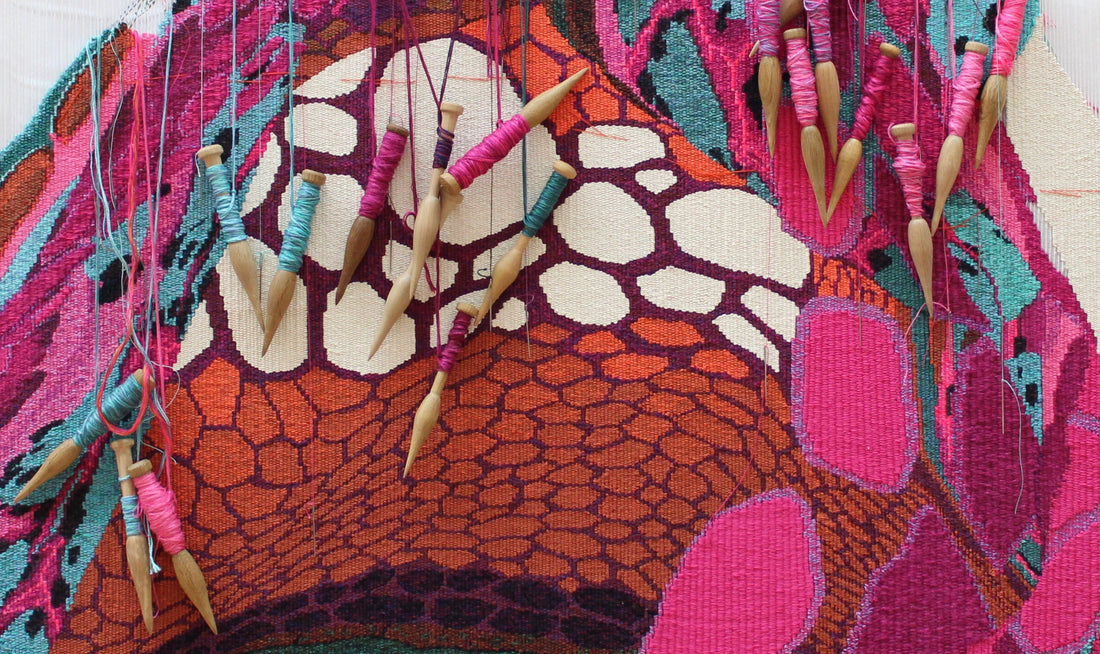
The Edinburgh Seven Tapestry
Dovecot Studios launches an innovative tapestry triptych at the V&A South Kensington to mark International Women's Day today, 8 March 2024. Designed by Christine Borland and created by Dovecot using a combination of traditional and modern materials and techniques, the work commemorates the 'Edinburgh Seven', the first women matriculate at any British university.
The Edinburgh Seven Tapestry will be on view in the V&A's Medieval & Renaissance Galleries from 8 March - 27 May 2024, before going on long-term display at the new Edinburgh Futures Institute at the University of Edinburgh this summer.
Matriculating as medical students in 1869, the 'Edinburgh Seven' fought an unsuccessful campaign to graduate and qualify as doctors. Their fights gained national attention, winning them supporters such as Charles Darwin, and ultimately results in the Medical Act of 1876 enabling women to be licensed as doctors. The University of Edinburgh awarded posthumous degrees to the Seven at ceremony in 2019, marking the 150th anniversary of their matriculation. The Edinburgh Seven Tapestry celebrates these pioneers with a design by the artist Christine Borland that incorporates technology initially developed for medical purposes. Using motion-capture, Borland recorded the movement of cloths in simple acts associated with care, medical training and research. The artist chose the magenta and cyan colour to represent the aniline dyes used in both the scientific staining of cells and textile in the 19th century.

The tapestry triptych took seven Dovecot weavers over 4,000 hours and 90,500 metres of yarn to create. Tapestry is one of the oldest fine art mediums, notably revived by William Morris and others in the late 19th century. Now with a contemporary approach, The Edinburgh Seven Tapestry, breaks new ground, demonstrating incredible technical ingenuity. Unlike traditional tapestry, the artwork has an organic shape based on a cellular structure in motion. Cotton, linen and nylon yarn and cotton warp create light and shadow, while the nylon weft adds transparency and reflective shine. Interpreting Borland's design, the weavers unpick large sections of cotton weft to create the outer shape and internal voids. The triptych can be moulded and shaped into sculptural forms. It will be suspended at the V&A above the 16th century statue of St Margaret and the Dragon (1530-40), who pregnant women once called upon for protection in childbirth.
The Edinburgh Seven Tapestry will be on view in the V&A's Medieval & Renaissance Galleries from 8 March - 27 May 2024.
Images courtesy of Dovecot Studios
Find out more:
dovecotstudios.com/blog/the-edinburgh-seven-tapestry-unveiled-at-the-v-a-south-kensington
The Edinburgh Seven Tapestry will be on view in the V&A's Medieval & Renaissance Galleries from 8 March - 27 May 2024, before going on long-term display at the new Edinburgh Futures Institute at the University of Edinburgh this summer.
Matriculating as medical students in 1869, the 'Edinburgh Seven' fought an unsuccessful campaign to graduate and qualify as doctors. Their fights gained national attention, winning them supporters such as Charles Darwin, and ultimately results in the Medical Act of 1876 enabling women to be licensed as doctors. The University of Edinburgh awarded posthumous degrees to the Seven at ceremony in 2019, marking the 150th anniversary of their matriculation. The Edinburgh Seven Tapestry celebrates these pioneers with a design by the artist Christine Borland that incorporates technology initially developed for medical purposes. Using motion-capture, Borland recorded the movement of cloths in simple acts associated with care, medical training and research. The artist chose the magenta and cyan colour to represent the aniline dyes used in both the scientific staining of cells and textile in the 19th century.

The tapestry triptych took seven Dovecot weavers over 4,000 hours and 90,500 metres of yarn to create. Tapestry is one of the oldest fine art mediums, notably revived by William Morris and others in the late 19th century. Now with a contemporary approach, The Edinburgh Seven Tapestry, breaks new ground, demonstrating incredible technical ingenuity. Unlike traditional tapestry, the artwork has an organic shape based on a cellular structure in motion. Cotton, linen and nylon yarn and cotton warp create light and shadow, while the nylon weft adds transparency and reflective shine. Interpreting Borland's design, the weavers unpick large sections of cotton weft to create the outer shape and internal voids. The triptych can be moulded and shaped into sculptural forms. It will be suspended at the V&A above the 16th century statue of St Margaret and the Dragon (1530-40), who pregnant women once called upon for protection in childbirth.
The Edinburgh Seven Tapestry will be on view in the V&A's Medieval & Renaissance Galleries from 8 March - 27 May 2024.
Images courtesy of Dovecot Studios
Find out more:
dovecotstudios.com/blog/the-edinburgh-seven-tapestry-unveiled-at-the-v-a-south-kensington
